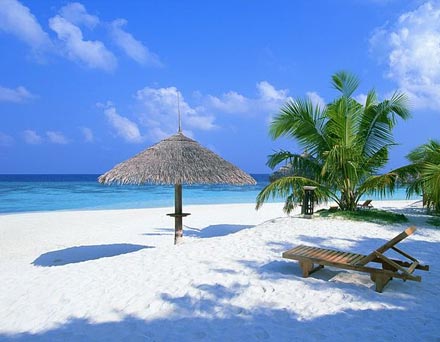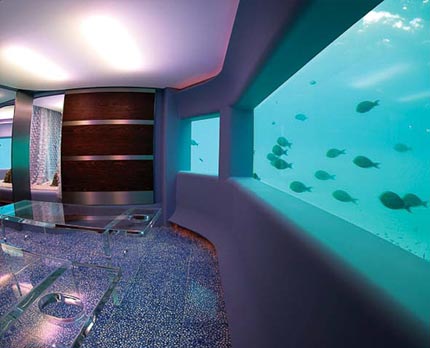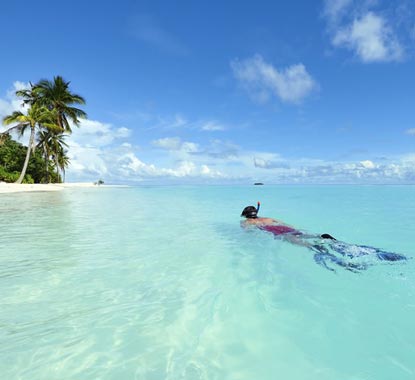Maldives
Country statistics

Total area: 116 sq miles (300 sq km)
Population (2012 est.): 394,451 (growth rate: -0.127%); birth rate: 15.12/1000; infant mortality rate: 26.46/1000; life expectancy: 74.69
Capital City: Malé
Monetary unit: Rufiya
Languages: Maldivian Dhivehi (official); English spoken by most government officials
Ethnicity/race: South Indians, Sinhalese, Arabs
Religions: Islam (Sunni)
Country introduction

Maldives is a country of South Asia, situated in the Indian Ocean, south, south-west of India and west of Sri Lanka. It consists of approximately 1,190 coral islands grouped in a double chain of 26 atolls, spread over roughly 55,923 sq miles (90,000 sq km), making it one of the most distinct countries in the world.
Maldives is made up of 90% of the sea, with the people of the islands widely dispersed across the atolls, with about 200 inhabited islands. About 90 islands are developed as tourist resort and the rest are uninhabited or used for agriculture and other livelihood purposes.
Composed of live coral reefs and sand bars, the atolls are situated atop a submarine ridge 960 km (596 miles) long that rises abruptly from the depths of the Indian Ocean and runs from north to south. Only near the southern end of this natural coral barricade do two open passages permit safe ship navigation from one side of the Indian Ocean to the other through the territorial waters of Maldives.
The largest island of Maldives is Gan, which belongs to Laamu Atoll or Hahdhummathi Maldives. In Addu Atoll the western-most islands are connected by roads over the reef and the total length of the road is 14 km (8 miles).
Most atolls of the Maldives consist of a large, ring-shaped coral reef supporting numerous small islands. Islands average only 0.6 to 1.2 sq miles (1 to 2 sq km) in area, and lie between one and 1.5 m (4.9 ft) above mean sea level. Although some of the larger atolls are approximately 50 km (31 miles) long from north to south, and 30 km (18 miles) wide from east to west, no individual island is longer than 8 km (5 miles).
The Maldives has no hills, but some islands have dunes which can reach 2.4 m (7 ft) above sea level, like the north-west coast of Hithadhoo (Seenu Atoll) in Addu Atoll. Islands are too small to have rivers, but small lakes and marshes can be found in some of them.
On average, each atoll has approximately 5 to 10 inhabited islands; the uninhabited islands of each atoll number approximately 20 to 60. Some atolls, however, consist of one large, isolated island surrounded by a steep coral beach. The most notable example of this type of atoll is the large island of Fuvahmulah situated in the Equatorial Channel.
The culture

The origins of the Maldivian people are shrouded in mystery. The First settlers may well have been from Sri Lanka and Southern India. Some say Aryans, who sailed in their reed boats from Lothal in the Indus Valley about 4,000 years ago, probably followed them. Archeological evidence suggests the existence of Hinduism and Buddhism before the country embraced Islam in 1153 AD. A scholar converted the king to Islam, and since then the whole country of Maldives has been practicing the religion of Islam. Being a seafaring nation, the culture of the Maldives is immersed in influences from many different countries bordering the Indian Ocean from India, Indonesia, Malaysia to Africa.
All the main Islamic festivals are followed in Maldives with great fervour, with the young and old all participating in the celebrations. Religious education is part of life for all and Islam is considered as a part of the school curriculum and taught with the same zeal as other subjects.
The Maldives were a British Protecorate from 1887 to 26th July 1965, during which time they were forced to consult the British on all foreign affairs in exchange for protection from other colonies. Every year, the end of this era is celebrated in the form of national parades, street parties and dancing. Schools spend a good deal of time preparing for the event and there are also demonstrations by the security forces. This reflects the actual level at which the day is celebrated and the people's feelings towards the holiday. The current political climate and overbearing Presidential influence means that many people see the celebration of independence at a personal level rather than at a national level. Many believe the country is far from achieving independence from the political powers that be, which is illustrated by the fact that the parades and celebrations are sometimes cancelled at the last minute by the government.
'Bodu Beru', literally translated Big Drums, is one of the most popular form or music and dance, especially in the Northern Atolls and is said to be of East African origin. It is a performance by a group of drummers, singers and dancers, starting with a slow beat ending on a frenetic note. Other popular cultural dance include the 'Thaara Jehun' for men, with its Arabic influences and 'Bandiyaa Jehun' for the women, similar to Indian Pot Dance where dancers mark the beat with a metal water pot, whilst wearing metal rings. Today Western and Indian music is much popular with both young and older Maldivians.

As the Maldives comprises more sea than land, it is only natural that fish (mainly tuna) have always been the most prominent element of Maldivian food. However, with travelers from different parts of the world, new seasonings and vegetables were introduced in to the country and added to the existing (limited) repertoire of seafood and tubers (e.g. taro and sweet potato). Each new discovery was incorporated into the diet in quantities most palatable to Maldivians. Thus Maldivian cuisine now comprises Arabic, Indian, Sri Lanka and Oriental tastes blended into a unique cuisine that embodies a culinary identity of its own.
Amongst traditional Maldivian handicraft are lacquer work, woven mats, coconut products, boat building, and jewellery. Lacquer is a highly artistic artwork, in which the craftsmen shape wood to make the objects of his desire, using a lathe. Each of the Maldivian handicrafts is particular to certain islands or atolls only. The best form of lacquer work can be found in the island of Thulaadhoo in Baa atoll. The island is popular for its wooden pots, vases and boxes of different sizes and shapes that exhibit delightful abstract and artistic patterns. Gadhdhoo Island is well known for fine and intricate mats that are hand woven. These hand woven mats are used by people as prayer mats and also for decoration. Another island in the Maldives, Rin'budhoo is renowned for its goldsmiths whilst Hulhudeli has a number of silversmiths.
The arrival of tourism has increased the collection and sale of "sea jewellery", such as coral, mother-of-pearl, black coral, seashell and turtle-shell. However, due to their endangered status and other environmental considerations, these products are now illegal for export.
Attractions & landmarks

There are many luxury island resorts scattered around Maldives where visitors can stay to experience the bright blue skies, all year sunshine, white sandy beaches and warm seas with an undisturbed exotic marine life. The Maldives has become a synonym for paradise whether it is for honeymooners, sun worshipers or scuba divers. Aside from the capital Malé, there are no hotels in the Maldives but only resorts, which take up an entire island consisting of luxury villas either on the beach or out near the ocean. Possibly one of the most extravagant places to stay in the Maldives is the Hufaven Fushi Underwater Spa Resort, which is marketed mainly towards honeymooners with its overly lavish rooms and personal dining rooms consisting of one table and two chairs on a platform out to sea. The real attraction however is the underwater spa, a series of rooms below the sea where visitors can enjoy the relaxing treatments and spa sessions while taking in the marine environment and wildlife. Most resorts provide water activities and excursions such as jet-sking, canoeing, dolphin cruises and island hopping by speed boats.
Malé also known as the Sultan's island, is the capital of the Maldives. It is a small, picturesque, and heavily populated city which is about 2 km (1.2 miles) long and 1 km (0.62 miles) wide. It is the commercial center, seat of government and the location of many important historical and religious landmarks. Nearly all visitors to Malé take time to visit the Grand Friday Mosque, Masjid-al Sultan Mohamed Thakurufaanu-al-A'z'am, which is the biggest mosque in the Maldives. It was built in dedication to the most bravest Maldivian heroes, Al-Sultan Ghazi Muhammad Bodu Thakurufaanu, who saved the Maldives from the Portuguese conquerors who ruled over the Maldives from 1558-1573. This grand mosque with its dominant golden dome decorates the facade of Malé and can accommodate over five thousand worshippers at a time. Another landmark worth visiting is the Hukuru Miskiy or the Old Friday mosque, which is considered the oldest mosque in the Maldives. Built in 1656 with coral stones, the interior and exterior walls of the mosque are beautifully carved with Arabic writings and other ornamental designs, the interior is particularly superb and famed for its fine lacquer work and elaborate woodcarvings. Visitors will also find the various ancient tombstones erected in its compound. Other important sites in Malé include the tombs of legendary saints, Mulee-aage - the previous Presidential Palace, the Presidential Palace built recently, and the national museum in the Sultan Park which shows the glories of a different era. Visitors to Malé are also recommended to visit the fish market, which is in full swing throughout the day with shops and stalls selling various goods and produce, and with all types of material being traded between people from the surrounding atolls. The busiest time is mid-afternoon when the fishermen bring in the day's catch, which is promptly laid out on the floor and sold.

The vast majority of the Maldives' land mass lies a fraction below the water level, and is probably the main attraction of the region. It can be explored extremely cheaply and easily with a snorkel, with the shallow waters offering a vast range of marine activity to take in. Snorkel trips are organised by most hotels and resorts, and in addition there are plenty of local guides operating their own boat tours to the most productive and more inaccessible spots. For those interested in diving, there are plenty of sheltered areas ideal for learning, as well as more open areas affected by currents. The latter have a higher flow of nutrients and so sustain more sea life, meaning that visitors are likely to come into contact with the larger marine animals such as sharks and rays.